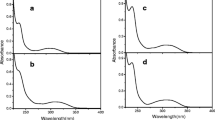Abstract
Molecular fluorescent sensors can be synthesized by covalently linking a photoactive fragment (e.g., anthracene) to a receptor subunit displaying affinity toward the envisaged substrate. The electron transfer process is the privileged signal transduction mechanism: redox active substrates (e.g., transition metals) typically release/uptake an electron to/from the proximate photoexcited fluorophore, the recognition being signaled through fluorescence quenching; redox inactive substrates (d0 and d10 metals, H+) deactivate an existing quenching relay (e.g., a tertiary nitrogen atom close to the fluorophore) and their recognition is signaled through fluorescence enhancement. An-ionic substrates can be conveniently recognized on the basis of the metal–ligand interaction: polyamine receptors containing the photophysically inactive ZnIIion bind the carboxylate group. In the case of amino acids,\({\text{NH}}_3^ + {\text{ - CH(R) - COO}}^ -\), selectivity is improved when the receptor platform bears additional groups capable to interact specifically with the R substituent. If R is capable of transferring an electron to the nearby photoexcited fluorophore, the recognition is signaled through fluorescence quenching.
Similar content being viewed by others
REFERENCES
A. Weller (1968) Pure Appl. Chem. 16, 115.
G. De Santis, L. Fabbrizzi, M. Licchelli, A. Poggi, and A. Taglietti (1996) Angew. Chem. Int. Ed. Engl. 35, 202.
L. Fabbrizzi and A. Poggi (1995) Chem. Soc. Rev. 197.
L. Fabbrizzi, M. Licchelli, G. Rabaioli, and A. Taglietti, unpublished results.
F. P. Schmidtchen and M. Berger (1997) Chem. Rev. 97, 1609.
L. Fabbrizzi, M. Licchelli, P. Pallavicini, A. Perotti, and D. Sacchi (1994) Angew. Chem. Int. Ed. Engl. 33, 1975.
V. Balzani and F. Scandola, Supramolecular Photochemistry, Ellis Horwood, Chichester, (1991).
L. Fabbrizzi, M. Licchelli, P. Pallavicini, A. Perotti, A. Taglietti, and D. Sacchi (1996) Chem. Eur. J. 2, 167.
A. P. de Silva and S. A. de Silva (1986) J. Chem. Soc. Chem. Commun. 1709.
A. P. de Silva, H. Q. N. Gunaratne, T. Gunnlaugsson, A. J. M. Huxley, C. P. McCoy, J. T. Rademacher, and T. E. Rice (1997) Chem. Rev. 1515.
A. P. de Silva, H. Q. N. Gunaratne, and C. P. McCoy (1996) Chem. Commun. 2399.
Author information
Authors and Affiliations
Rights and permissions
About this article
Cite this article
Fabbrizzi, L., Licchelli, M., Parodi, L. et al. The Molecular Design of Fluorescent Sensors for Ionic Analytes. Journal of Fluorescence 8, 263–271 (1998). https://doi.org/10.1023/A:1022513918542
Issue Date:
DOI: https://doi.org/10.1023/A:1022513918542




